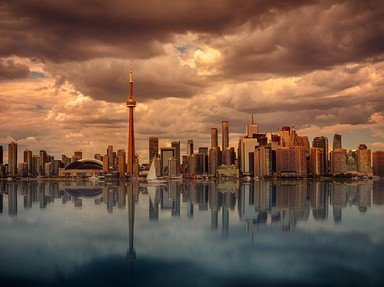Quiz Answer Key and Fun Facts
1. Trains like this one were able to cross Canada "from sea to shining sea" in 1885 when the last spike was driven at Craigellachie, British Columbia, to complete the Canadian Pacific Railway. For Canada's Centennial celebrations in 1967, a Canadian folksinger was commissioned by the Canadian Broadcasting Corporation (CBC) to compose a song honoring those who toiled for many years to complete the project. Who was that entertainer who wrote "The Canadian Railroad Trilogy" for this project and also wrote songs about the sinking of a cargo vessel on Lake Superior in 1975 and the Detroit race riots of 1967?
2. Pictured is an officer of the Royal Canadian Mounted Police, Canada's national police force. All candidates for the force are trained at the institution's Academy in Regina. As such, what prairie province is represented by this living sculpture?
3. The flower represented by this photo is the floral emblem for the province of Alberta. What flower do you think it is?
4. This photo shows the living sculpture of the Atlantic puffin, the official bird of which Canadian province, the last one to join Canada's confederation in 1949?
5. Representing Quebec is this photo of "The Three Ships from France". What French explorer conducted three voyages to explore Quebec along the St. Lawrence River in 1534, 1535-6, and 1541-2.
6. From September 1-9, 1864, representatives from Canada's various colonies met to discuss the prospects of confederation at what came to be known as the Charlottetown Conference. In what area of Canada is Charlottetown located, also home to the living sculptures of the red fox in the accompanying photo?
7. New Brunswick's sculpture is the Canadian horse. How did these animals come to be in Canada?
8. The stylized living sculpture pictured here is that of the orca, the "killer whale". Among its habitats are the waters of the North Pacific Ocean. What Canadian province borders that particular body of water?
9. This photo represents Nova Scotia and it is apparent that the fellow is engaged in some sort of fishing activity. Given the clues in the photo itself, what is he trying to catch?
10. This particular series of plant sculptures portrays a polar bear on the right, a wolf baying on the bottom left and the big item resembling a cross is a symbolic inukshuk representing the Aurora Borealis, otherwise known as the northern lights. In which community in Manitoba, on the shores of Hudson Bay, would you be able to see all these things?
11. The last province honored in this quiz will be Ontario. Although the character seen in this photo probably lived in Montreal and was French-Canadian, he worked primarily in Ontario and points west. What was he called?
12. This fellow is obviously panning for gold. Below is a series of dates, the span of which signifies the period of time for four gold rushes in various parts of the world. The Great Klondike Gold Rush in Canada's Yukon Territory took place during which period?
13. Canada's Northwest Territories are home to these beautiful beasts. What are they?
14. Our last provincial or territorial living sculpture is coincidentally representing the last geographical area to be accorded territorial status in 1999 when it was formally separated from the Northwest Territories. This drum dancer is therefore a resident of what territory?
15. The living sculpture in this photo represents a famous Canadian "Anne". Which one do you think it might be?
16. This image represents the poppy referenced in a poem entitled "In Flanders Fields" composed by a Canadian soldier during World War I. Flanders Fields, noted for its poppies, was the site of several WWI battles near the municipality of Ypres. Where in the world is Flanders Fields?
17. This sculpture of a piano pays tribute to one of Canada's most famous musicians, Glenn Gould. With what genre of music was he most closely identified?
18. MosaiCanada could not possibly ignore "The Goal"! What event is depicted in this scene?
19. Pictured here is Wisakedjàk. Studying this picture closely, you might recognize that this subject of native legend could have a parallel in the Old Testament. Who might that be?
20. Our last image of a living sculpture at MosaiCanada is Aataentsic. What would we know her as in English?
Source: Author
maddogrick16
This quiz was reviewed by FunTrivia editor
trident before going online.
Any errors found in FunTrivia content are routinely corrected through our feedback system.
